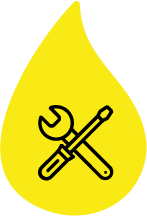Flooding is an issue in Chicago’s Irving Park neighborhood, especially in the Old Irving Park area. There were 2 major storms that occurred in 2010 and 2013 and they produced up to 5 ½ inches of rain. Like most of Chicago, there are no reservoirs, and with the density of buildings, streets and parking lots, there is very little green space to absorb or slow down the onslaught of water in a heavy rain. Because the city of Chicago has a combined storm and sanitary system it means that every time there’s a serious rainstorm, sewers can backup, and people get water and worse in their basements. Couple that with sewer pipes that need to be enlarged and replaced and you have trouble areas. Parks’ Plumbing & Sewer, Inc. has been providing flood control systems including sewer backflow valves and overhead sewers to Chicago’s Irving Park neighborhoods since 1981. Call today to protect your home and possessions.
Chicago’s Irving Park is located about 7 miles northwest of the Loop. It is bounded by the Chicago River to the east, the Milwaukee Road tracks to the west, Addison street to the South and Montrose Avenue to the north. The original name chosen was Irvington, named after the author Washington Irving but was changed to Irving Park when it was found another Illinois town had already used the name.
Development of the area began in 1843 when Major Noble purchased 160 acres for farming. After many years of farming he sold the property to a group of New Yorkers who decided to subdivide the property and create an exclusive settlement. Once the Chicago & Northwestern Railroad built a station, the area was well on its way. After the Chicago Fire in 1871, many more city residents were looking west for less crowded areas to live. In 1889 the community was annexed to Chicago along with the rest of Jefferson Township.
Old Irving Park is a neighborhood within Irving Park comprising its historical core. Its borders are Montrose to the north, Addison to its south, Pulaski Road to the east and Cicero to the west, the same borders as the original two farms that developed there in the 1870s.
The Villa district has borders of Pulaski Road to the west, Addison to the south, Avondale Avenue to the north and east, was built in 1902 by several architects, many of them visibly influenced by Frank Lloyd Wright’s Prairie Style. It contains many unique Craftsman and Bungalow style homes fronting on boulevard style streets. The area is home to many of Polish decent.
Independence Park is a neighborhood within Irving Park that was developed in the 1800s. Its borders are Irving Park Road to the north, the Kennedy Expressway to the west, Elston Avenue and Central Park Avenue to the east, and Addison Street to the south. It has a park of the same name which was one of the finest landscaped neighborhood parks in the city for many years.
West Walker is a neighborhood within Irving Park that comprises the area bounded by Irving Park Road to the south, Pulaski Road to the west, and Elston Avenue to the northeast. It is characterized by large single family homes in late Victorian, Foursquare and Revival styles.
California Park is a neighborhood located in the eastern portion of Irving Park that began development in the 1920s. Understated single-family homes and family-owned businesses are a common feature. Its borders are Montrose Ave. to the north, Addison St. to the south, Kedzie Ave. to the west, and the Chicago River to the east.
Kilbourn Park (Milwaukee to the north, Belmont to the south, the Union Pacific/Northwest rail line to the east, and Cicero to the west) is a primarily middle class residential and industrial area.
Merchant Park (Addison to the north, Belmont to the south, the Union Pacific/Northwest rail line to the West, Pulaski Road (to the east) has been in recent years relabeled as “South Old Irving Park” by some.
Little Cassubia is a historical neighborhood in the Irving Park Community Area between Irving Park on the North, Addison to the South, Kimball to the West and Kedzie to the East. The name “Little Cassubia” was coined by locals because of the Kaszub people living in the area, who also founded the Roman Catholic Parish of Immaculate Heart of Mary.
Irving Park’s population grew from 49,489 in 1980 to 58,643 in 2000. During those twenty years, the Hispanic population increased from 9 percent to 43 percent, and included immigrants from Central and South America along with larger numbers of Mexicans and Puerto Ricans. Filipinos and Indians predominated among Asians, who constituted 8 percent of the population in 2000.


